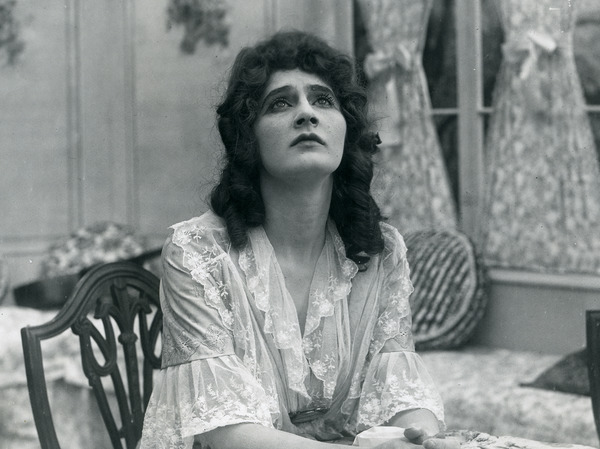THE PLOUGHSHARE
John H. Collins (US 1915)
Opening The Ploughshare with a quote from James Russell Lowell’s 1850 poem “After the Burial” probably wasn’t the best idea, since the rich language of the stanzas (“that dull shock / When the ploughshare of deeper passion / Tears down to our primitive rock”) refers to a profound grief that has no resonance in the film. The blame surely lies with Mary Imlay Taylor, a relatively popular author of the era best known for historical romances, who’d been occasionally writing scripts for Edison since 1912. Her scenario for The Ploughshare isn’t her most coherent effort, and that has nothing to do with missing sections in the surviving print, some of which are bridged over with stills. Louis Reeves Harrison in Moving Picture World (25 September 1915) complained that she “has a tendency to scatter her forces,” though Collins does his best to offset the over-wieldy narrative with moments of visual interest.
This was Collins’ third 4-reeler for Edison, after Cohen’s Luck and On Dangerous Paths, both presumed lost, and is set in the ever-popular antebellum South, just as plantation owner Judge Lawrence (William West) expires, surrounded by family and slaves (unfortunately I’ve been unable to find any credit information for the African-American actors) in a scene that has a peculiar tableau vivant quality. The Judge leaves two sons, upstanding William (Robert Conness) and his horrid young half-brother Jim (Richard Peer as a child, Augustus Phillips as an adult). Twenty years later, William is elected Governor and falls in love with Helena Leigh (Gertrude McCoy), who’s infatuated with his caddish half-brother. This is especially problematic, as Jim has impregnated and abandoned Jenny Strong (Bessie Learn), whose brother Jack (Robert Walker) confronts her seducer, who shoots him dead.
Helena’s father (Bigelow Cooper) insists she marry William despite her passion for Jim, who’s framed Arthur Willet (Philip Quin) for Jack’s murder. Learning of Jim’s guilt, Helena is convinced he acted in self-defense, and she engineers his escape; the scandal forces William to resign the governorship. To clear her husband’s name, Helena declares herself an accessory to Jim’s flight from justice, and is about to kill herself when William appears and tells her that Jim has died in a canoe accident in South America, where he had fled with an earlier sweetheart, Evelyn Clayton (Margaret Prussing).
The notoriously scissor-happy censors in Chicago forced several cuts, including the intertitle, “My sister is the last girl you will ever wrong,” though such excisions wouldn’t have made the improbable twists and turns any easier to follow. Collins tries to save the flawed source material with some interesting staging, especially in outdoor scenes such as a surprisingly dignified moment featuring a shirtless slave in a field, but often the shots are over-crowded like the narrative itself. Robert Conness indulges in melodramatic gestures that already feel outdated, though Gertrude McCoy delivers a more nuanced performance. The Colonial-style house used for the Lawrence plantation was “Brookside,” the estate of Mrs. William H. Parsons in Rye, New York, which had been rented to tobacco heir George Arents, Jr., who hosted an intimate gathering of one hundred friends in his Fifth Avenue apartment for a private screening of the film.
Jay Weissberg

regia/dir: John H. Collins.
scen: Mary Imlay Taylor.
cast: Gertrude McCoy (Helena Leigh), Augustus Phillips (Jim Lawrence), Robert Conness (il governatore/Governor William Lawrence), William West (il giudice/Judge Lawrence), Richard Peer (Jim Lawrence da bambino/as a youth), Frank A. Lyon (Curwood), Bigelow Cooper (Dr. Nelson Leigh), Helen Strickland (Madame Clayton), Margaret Prussing (Evelyn Clayton), Philip Quin (Arthur Willet), Bessie Learn (Jenny Strong), Robert Walker (Jack Strong), Henry Leoni (sceriffo/Sheriff).
prod: Edison.
dist: General Film Company.
uscita/rel: 01.10.1915.
copia/copy: DCP, 43’17” (da/from 35mm, 3870 ft.; orig. c.4000 ft., bn/b&w, col. [imbibito/tinted]); did./titles: ENG.
fonte/source: Museum of Modern Art, New York.
Restauro effettuato nel 2018 da/Preserved 2018 by The Museum of Modern Art, con il sostegno di/with support from The Celeste Bartos Fund for Film Preservation.
Scansione a 4K da un master 35mm a grana fine ricavato dal negativo originale; varie didascalie mancanti sono state ricreate digitalmente a partire da un copione presente nel fondo Edison del MoMA. / Scanned at 4K from a 35mm fine grain master printed from the original negative. Several missing titles digitally recreated using text from a script in MoMA’s Edison files.


 Italiano
Italiano